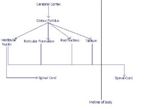Motor Pathways - Anatomy & Physiology
Revision as of 14:38, 14 August 2009 by A.allison (talk | contribs) (New page: {{review}} {{toplink |linkpage =Nervous and Special Senses - Anatomy & Physiology |linktext =Nervous and Special Senses |maplink = Nervous System and Special Senses (Content Map) - Anatom...)
| This article has been peer reviewed but is awaiting expert review. If you would like to help with this, please see more information about expert reviewing. |
|
|
Introduction
Motor pathways carry signals from the cerebellum to the skeletal muscle. The system consists of upper and lower motor neurones. Upper motor neurones are located mainly within the neopallium of the cerebellum. They govern the excitation or inhibition of lower motor neurones. Connections of upper motor neurones with lower motor neurones are grouped into two pathways.
Pyramidal System (Corticospinal)
- Produces fine movements associated with skill, e.g. writing and playing a musical instrument.
- Most developed in primates, although may exist in other species such as the cat, where it aids in grooming.
- Nerve fibres of the pyramidal system originate in the cerebellum, and then pass to the thalamus, and medulla oblongata.
- Some fibres decussate in the medulla oblongata, whilst others remain ipsilateral until they leave the spinal cord where they cross the midline of the body.
- Nevertheless, all fibres cross the midline at some point, so that the left side of the brain controls the right side of the body and vice versa.
Extrapyramidal System
- Distinguishable from the pyramidal system as tracts do not run within the pyramids of the medulla.
- Earlier evolutionary development than the pyramidal system, so is a feature of lower animals and is the most important system in domestic species.
- More complex than the pyramidal system as involves various multisynaptic pathways that relay within several nuclei in the brain.
- Nuclei are dispersed from the telencephalon to the medulla oblongata and may be visible grossly.
- Parts of it take origin from the motor cortex, others from the tectum and reticular formation.
- Neurones then relay within nuclei which include:
- Red nucleus
- Substantia nigra
- Caudate nucleus
- Subthalamic nuclei
- Olive in the medulla oblongata
- Reticular formation
- Neurones that relay in the red nucleus and reticular formation relay directly onto LMNs, others relay to other nuclei.
- The main descending motor tracts from these two nuclei are:
- Rubrospinal tract - important in carnivores and ungulates. Modulates pattern generators in the spinal cord.
- Reticospinal tract
- Vestibulospinal tract
- Tectospinal tract

